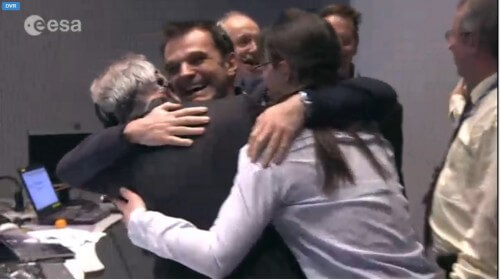This is what the director of the control room at the control center of the European Space Agency defined after the soft landing of the lander Philae on comet 67P Churyumov Garsimenko this evening * Live report from Darmstadt special for the website

Update 19:15 Israel time: The Philae lander did land but its anchors, or at least some of them, did not stick to the ground. This is what Paolo Perry, the director of the Philae landing project on Comet 67P, said. As a result, the telemetry data arrives interrupted and not in a continuous transmission, firstly the European Space Agency is happy that there is a transmission, and currently an effort is being made to stabilize the transmission.
18:10 Israel time: Ten and a half years after its launch, the European spacecraft Rosetta set another record in the history of the space program. A lander named Philae that came out of it made a soft landing this evening (17:02 CET - actually about 20 minutes earlier - the delay due to the speed of light at a distance of 500 million km).
"We are on the comet," said this evening the director of the control room at the control and control center of the European Space Agency in Darmstadt, immediately after the approval was received for the soft landing of the Philia lander, a small spacecraft that is one meter wide and one meter high, exactly at the landing site on a comet that is about 4 kilometers long - 67P Vryumov Gersimenko.
The landing took place seven hours after the separation of Philae from the mother spacecraft Rosetta, and in accordance with the plans established. The preparations went almost smoothly with the exception of an hour's delay in giving permission last night due to the fear that one fuel tank had not been opened, but in the end it was decided to continue the process towards the separation and landing despite this.
We have telemetry, but we don't know for sure how the landing was made. We see the lander sitting on the ground, Philia talking to us, and we expect more data soon. We are on the comet"
The director general of the European Space Agency, Jean-Jacques Dordin, said immediately after receiving the confirmation of the smooth landing: "This is a big step for human civilization, science, scientists, knowledge that will be added to human culture."
"The main problem with success is that it seems easy, especially for us, the managers who do nothing, but when you know the total of persistence, hard work, international cooperation, you know that this kind of success does not fall from the sky but from hard work and expertise. The only way to overcome risks is through specialization. Today we illustrated the European professionalism - in the European Space Agency, in the industries, in the state space agencies. We have demonstrated the European capacity, we have established primacy and no one can take that away from us." Dordin concluded.
Later this evening the Philaya landing is expected to broadcast images, including a panoramic image of the landing area. We will continue and update

21 תגובות
I actually remember that a few years ago there was a spacecraft that passed through the trail of a comet, collected samples and returned them to Earth... Here I found:
https://www.hayadan.org.il/%D7%93%D7%92%D7%99%D7%9E%D7%95%D7%AA-%D7%9E%D7%9B%D7%95%D7%9B%D7%91-%D7%A9%D7%91%D7%99%D7%98-%D7%99%D7%97%D7%A9%D7%A4%D7%95-%D7%9E%D7%99%D7%93%D7%A2-%D7%A2%D7%9C-%D7%9E%D7%A2%D7%A8%D7%9B%D7%AA-%D7%94
The next step is to bring a sample from Mars or an asteroid to Earth. Sometimes it seems that space exploration is stuck. But we live in an interesting time.
Response to the test
Sent from a home computer
Ha Chen, everything is fine, there are also screws coming out of the landing gear.
If they find microbes there, could that explain a lot?
Good luck, waiting for the photos.
thank you Ms.
And I sent from a computer, from a Chrome browser.
On the science website it says a real flying saucer Meir
To all those who responded, did you send your response from a mobile device? Or from a regular PC?
Trying to send a reply
Hen, this means that the probe is held only by the very weak lubrication force of the comet.
And this means that every step must be very balanced, otherwise you may lose the probe because it will simply fly away from the comet.
Without the anchors what can happen?
The next target is Phobos and it is possible. When the Mars Express spacecraft reaches the end of its journey, it will be possible to direct it towards landing on Phobos in the same way that the Americans landed the NEAR spacecraft on the asteroid Eros.
Philae's anchors have not opened, they are currently only on the comet but not anchored to it.
Beyond that, does anyone know if Israel had a part in the mission?
This response was probably successful because it was sent via a router, but from a normal computer the response is not received and the page simply falls.
Site manager AB, are you aware that for several days it is not possible to send comments on the site? Does anyone handle this?